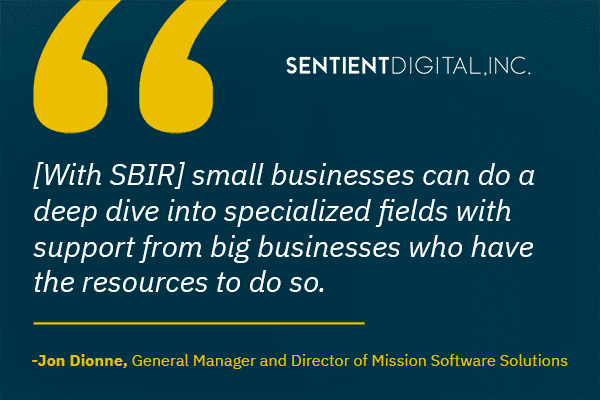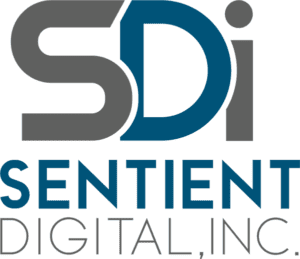Looking for SBIR help from a company that has been through the process? The SBIR program provides an opportunity for small businesses like yours to compete for government and military contracts that would otherwise be out of reach. If you have heard about this program and wonder if it can help level the playing field between large and small tech companies when it comes to performing work for the government, read on to better understand the SBIR program and how it has fostered success for Sentient Digital, Inc. and its subsidiary, RDA.
SBIR Qualifications
In order to be eligible for the SBIR program, a business must qualify as a Small Business Concern (SBC). These qualifications involve attributes related to ownership, size, influence within your industry, location, and legal form. You will then proceed through the phases of the process, which can be seen on this roadmap. But what do real people who have gone through the SBIR process say about it?
You can learn for yourself what it’s like to go through the program, from real people who have experienced the entire SBIR process. Here are the insights as provided by Jon Dionne, General Manager and Director of Mission Software Solutions; Ron Buratti, Senior Technical Advisor; and Gregory Niehaus, Manager of Engineering Development.
The SBIR Process, According To RDA Employees and Leaders
The Navy will prepare, release and request response to a public calendar of SBIR topics. These topics range from unmanned drone systems to underwater acoustic systems. Interested parties are then given approximately two months to coordinate their response.
In the first month, the RDA team will review the topic list, discuss with the topic sponsors to better understand what they’re looking for, and start to run a few different approaches by the sponsors of what the team is envisioning. In the second month, the team will start developing the technical proposals and documents to submit a full package of their proposal before the deadline.
If RDA wins their proposal, then they start working on the Phase I Base and Option (explained below). Phase I Base and Option help to develop the whitepaper and evaluate a project’s viability. Several companies will compete for the Phase I Option. If the team doesn’t win the Option, then they wait for the next set of topics to be released. After Phase I, Phase II will consist of building prototypes (which includes developing the software and hardware). Phase III has the team refining the technology for future fleet use.
From the time the first proposal is submitted, all the competing companies are judged blind to give them a fair chance. To select a winner, there are many different criteria and factors depending on the project. It can vary from most improved over time, the most reliable option, the project with the easiest transition path, and more. Companies can share their results with sponsors as the project continues, whether it’s processing improvement, noise reduction, or another related field.
Jon Dionne further explains that “Phase I is planning it out, Phase II is prototyping, and Phase III is developing a working model. The goal of Phase I is to determine the technical and commercial feasibility of the proposed research or technology. The goal of Phase II is to continue the development of the technology that we found to be feasible in Phase I. Businesses are expected to deliver a prototype or proof of concept of their technology. Phase III commercializes the technology, refining the prototype until it becomes a finished and viable product.”
He also mentions that “…there can be an in-between phase, called Phase 2.5, in which a company can explore another realm or aspect of their project that it didn’t have the time or the budget for in the previous Phase II.”
How Long Does Each Stage of The SBIR Process Take?
Here is an approximate overview of the SBIR Timeline:
- Phase I Base and Option (1 year)
- Phase II (2 ½ years)
- Phase 2.5 (18 months to 2 years)
- Phase III (5-10 years)
Over all, the program timeline depends on many factors including when the sponsors’ response to the proposal is received.
Important Terms: Base and Option
- Phase I Base and Option
-
-
- Base – In the Phase I Base, there are multiple companies that will be competing for contracts. At the end of the Base period, one company will be selected to move on to Phase II and continue with the Phase I Option.
- Option – In Phase I, the Option reduces time breaks and offers more funding to wrap up the project before the commencement of Phase II. It is essentially a grace period to let the company prepare for Phase II and hit the ground running without losing momentum.
-
- Phase II Base and Option
-
-
- Base – The Phase II Base has the same function as the Phase I Base except there are no competitors. The company will still share results of how they’ve improved and show progress to receive the rest of their funding.
- Option – The Phase II Option is the same as the Phase I Option, helping the company transition over to Phase III.
-
What Is The SBIR Process Like For Those Who Apply?
The proposal phase starts once the calendar of SBIR topics has been released. Any eligible company can go through the list of topics and submit an online application.
Gregory Niehaus says that the proposal phase can work for any company. “Anybody can apply. Typically, there are three companies that are chosen for Phase I and one company that is then chosen to continue to Phase II. You know who the other companies are in Phase I, but it’s all independent work. You do reach out to hardware manufacturers in Phase II to help with developing prototypes.”
The SBIR process includes project checks that allow the sponsors to monitor progress. If a company is not making good progress, they can automatically stop the project.
Ron Buratti also noted changes since his very first SBIR proposal in 1995, stating that where once the team would allocate 40+ hours into a single proposal, now “…they’ve limited the number of hours that a small company can put into it. They don’t want the small businesses spending a lot of money since that can come later with winning the projects. They’ve also loosened up Phase 2.5, in allocating more funds to help them succeed.”
How Does SBIR Help Small Businesses?

One of the best benefits of SBIR is that small businesses can do a deep dive into specialized fields with support from big businesses who have the resources to do so.
Gregory Niehaus shares that “…the SBIR program encourages people in the military to look at cost-effective solutions. Bigger companies may have the resources, but they are also more expensive. SBIR allows for rapid technology development and cost-effective solutions, while providing the government with a comparatively inexpensive means of determining if a selection of technology improvements is feasible.”
The proposal process may also help a company identify certain areas of improvement within a certain topic. Even if a company doesn’t win the proposal or subsequent phases, they can still assist the Navy in other ways and have a strong connection with them that can benefit the company.
You may ask, what about data rights? Will the project I submit be protected? Under the SBIR Program, small companies have full right and title to the data they develop under the SBIR award. Data is protected from disclosure for 20 years, and there are additional proprietary data rights protections. For example, RDA’s LCAP is protected under these proprietary data rights. To learn more about data rights, visit the Navy SBIR site to read through frequently asked questions.

Additional Perspectives on SBIR
From starting careers to developing new business connections, the SBIR program has opened many opportunities for RDA and its engineers. Read on to learn more about their experience working with the program.
Jon Dionne, General Manager and Director of Mission Software Solutions
“The SBIR program is how I initially got started at RDA. Ron Buratti was working on a couple SBIR’s. He had written the proposals and was looking for someone to flesh out or build those ideas. Those projects were turned into Phase II’s. From there, it helped us to develop strong relationships with clients. As those activities got started, we helped with the test support, data collection, and data analysis. We currently have multiple ongoing projects.”
“The Navy has turned to us to develop technological systems for them, and we’ve been able to develop and deliver those systems to them to integrate into their software suite.”
“As a small business, SBIR lets us dive into a specialized subject and help test products. We test current software configurations and use LCAP to monitor data, use that to make corrections.”
Gregory Niehaus – Manager, Engineering Development
“RDA benefits from the SBIR program by having a funding source for its R&D work. We work with manufacturers, which helps us to branch out and work with others in the industry, and forge new relationships.”
Ron Buratti – Senior Technical Advisor
“I got started in 1995 and wrote two proposals for two Phase I SBIRs, the first two that RDA won. One of those went all the way to Phase III.”
“Choosing SBIR topics from the list beyond our usual customer base can help us broaden it beyond NAVAIR. The more robust it can be, the more we can connect and grow with more individuals and form those different perspectives. The Army and Air Force have different needs related to a project. We can take one project and apply it differently to meet those different needs. It can be on a ship instead of an airplane. There’s usually enough overlap that we’re qualified to win those proposals, and there’s enough difference in the agencies that we connect with that we’re able to broaden out and try new things.”
Find Out More About SBIR and Get Your Contracting Questions Answered
Have more questions about the SBIR process? Sentient Digital and RDA have additional insights to share. Contact us if you are interested in partnering with us and check out our blog for more information about contracting for the government and military.




